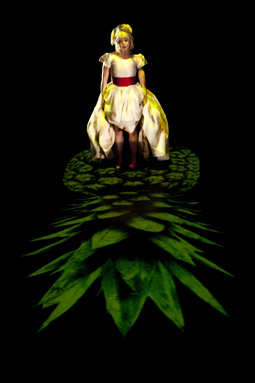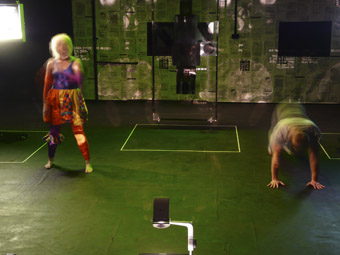fractured selves
douglas leonard: lisa o’neill; genevieve trace & kieran law

Lisa O’Neill, The Pineapple Queen
photo Sean Young
Lisa O’Neill, The Pineapple Queen
HOWEVER IDIOSYNCRATIC, LISA O’NEILL IS AN ICONIC QUEENSLAND DANCER, ACTOR AND NEW MEDIA ARTIST. WITH HER OWN DEEP SENSE OF IRONY, THE PINEAPPLE QUEEN MIGHT SEEM TO HAVE BEEN INTENDED TO SELF-REFLECT THIS CULT STATUS, AS INDEED IT DOES, BUT NOT IN A WAY PERHAPS MANY OF US EXPECTED.
the pineapple queen
This collaborative performance piece at the Roundhouse Theatre began as a more condensed, feral affair gleaned from a reworked script by writer Norman Price in 2004 as part of a series of Dada inspired performances around Brisbane. This piece and its developments, one says admiringly, exhibited O’Neill’s usual strengths. However, the La Boite showing added a new dimension of transparent vulnerability to O’Neill’s performance and repetoire. Strong dramaturgical input from director Ian Lawson elastically stretched definitions of both theatre and performance for La Boite who showed nerve in mounting this production.
The Pineapple Queen is presented through short scenes and minimal effects reminiscent of Buchner’s Woyzeck retold in a rural Queensland setting. The crucial elements in Buchner’s play—the dark pool (love and suicide) and the encroaching storm (Woyzeck’s madness)—are reproduced to similar effect in this production by the mysterious “coal hole” and the storm over the Glass House Mountains. However, as the Glass House District Pineapple Queen, it is O’Neill who is going mad, and her romantic self-confabulations and grand illusions are butresses against this end. As her defences crumble, the domestic brutality and squalor of the protagonist’s marriage are revealed in a final directorial coup which exposes O’Neill’s character as no longer capable of ‘acting.’ It is as if we are seeing Buchner’s Marie further down the track with her Sergeant, with all the nasty implications of history implacably repeating itself. In the final fadeout on the dethroned queen, cringing without any armour, it is as if we too have been effectively shut out from the text, along with her, denied a voice in history.
If the voice of history is patriarchal and monological, where are our vaginas? The central image of the hole in the Golden Circle Pineapple and the ellipses implied by the “coal hole” alert us to the gaps in consciousness, language and the body where real possibility for dialogue in this dark fairy tale exists. But Ian Lawson’s narrative uptake drives the play like a detective story, providing clues to the Queen’s madness, and this is indeed intriguing while ironically we are complicit from this monolithic vantage point in excluding her voice. But that a realistic explanation would ever be sufficient clue is moot given that the cause of her trauma is so shockingly and symbolically overdetermined in what is proposed in the final analysis—that she was forced as a child to assist her mother to self-abort with a baling hook, and that she herself repeats this familial cycle of violation. Her own comically depicted abortion of a pineapple after a vicious rape has an appropriately hallucinatory edge.
Despite such shocking imagery, this production sustained an uncanny poetic flow, all the elements contributing to maintaining a heightened feel that this woman is trying, above all, to survive and live. Price’s text this time is more spacious and allows the performance to move forward adeptly. Michael Coughlan, as the Pineapple Queen’s husband, delivers a superbly timed, immaculate performance of restrained emotion and potent physicality. The animations by Jaxcyn, projected onto the floor, such as the pineapple process plant at which The Pineapple Queen presumably worked in a menial position, or the expanding flower arrangement on which O’Neil danced, is simply the best integrated video design I’ve seen in a very long time. These were matched by David Walters’ subtle lighting and portentous music from Guy Webster.
There seem to be two versions of The Pineapple Queen. The earlier, more surreal version was easier to laugh at; the second is harder to watch, but equally rewarding in very different ways. In the first, The Pineapple Queen resorted to an axe to decentre authority or perhaps, more importantly, to perform a creative, purposeful act of self-authority. In this one, we see the performer Lisa O’Neill make a huge leap with the assistance of generous collaborators to lay herself open to dialogue with multiple voices.

Genevieve Trace, Kieran Law, Transverse Fracture of the First Metacarpal
photo Yvette Turnbull
Genevieve Trace, Kieran Law, Transverse Fracture of the First Metacarpal
transverse fracture of the first metacarpal
Another work in the physical performance vein was Transverse Fracture of the First Metacarpal performed as part of the Independents 2009 season at the Sue Benner Theatre at Metro Arts. This often disarming but deceptively contrived piece dealt with personal encounters with physical injury and rehabilitation by the co-creators Kieran Law and Genevieve Trace. That this might be of major industrial concern for starting out artists was emphasised, coincidentally, by the fact that only relatively recently did mid-career artist Lisa O’Neill return to performance after significant time out due to injury. Curiously, the shows bear a resemblance.
Law and Trace warmly engage with the audience and each other, developing a neat patter between them and bearing lightly on their physical injuries. Trace is particularly funny as she clowns through the story of how she seriously hurt herself while in the original daffy costume she wore on stage as a teenage performer. Law plays a more bashful muggins when he describes the usual dumb things young men do that resulted in his own injuries, although, to be fair, Trace unrepentantly confesses to having her nose broken in a stupid fight with her sister.
There’s an underground tension that emerges darkly to counter this lightness. This transverse fracture in the proceedings is well managed by the performers as they disengage from the audience and each other, entering another world of their own. Thom Browning’s low key electronica inundates the space to create a moody uneasiness perfectly complemented by Whitney Eglington’s spare lighting design. Two medical light boxes suspended in the space illuminate the brain scans and x-rays of broken bones held up to them in classic gestures that recreate to strong effect the still moment of anguish and horror before a patient’s life or death sentence is pronounced. Law’s Suzuki-based and Trace’s circus style of repetitive choreographed movement performed with absolute focus likewise served to prolong this moment to an unnerving extent considering the real risk of injury in this context.
This was a sophisticated and interestingly constructed show—the moment of disconnect, the movement into abstraction, was similar to the act of severence performed by O’Neill in The Pineapple Queen wielding her axe, and for the same reasons. Law and Trace, by cutting ties to their own self-narratives, seemed to be staking claim to new and uncharted territory on a level basis with the audience. Given their obvious skills and commitment, it will be interesting to see how their future work develops with larger subject matter. As a footnote, I’d like to mention the salient influence I’ve been observing that OzFrank has been having on two generations now in Brisbane.
The Pineapple Queen, creators Norman Price, Lisa O’Neill, writer Norman Price, director, dramaturg Ian Lawson, performers Lisa O’Neill, Michael Coughlan, sound composer Guy Webster, lighting design David Walters, costume design Glen Brown, video design Jaxzyn; Roundhouse Theatre, Brisbane, July 28-Aug 8; Transverse Fracture of the First Metacarpal, co-devisors, performers Genevieve Trace, Kieran Law, sound design Thom Browning, lighting design Whitney Eglington; Sue Benner Theatre, Metro Arts, Brisbane, July 9-25
RealTime issue #93 Oct-Nov 2009 pg. 47






